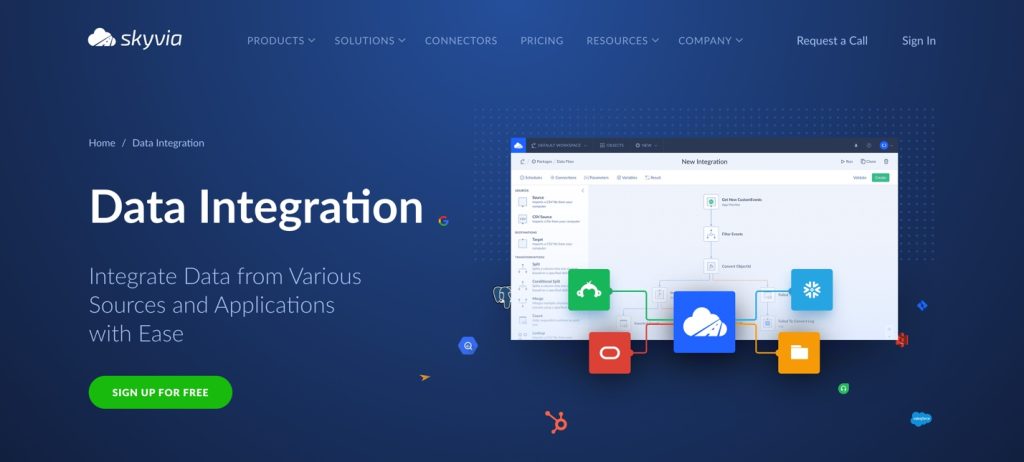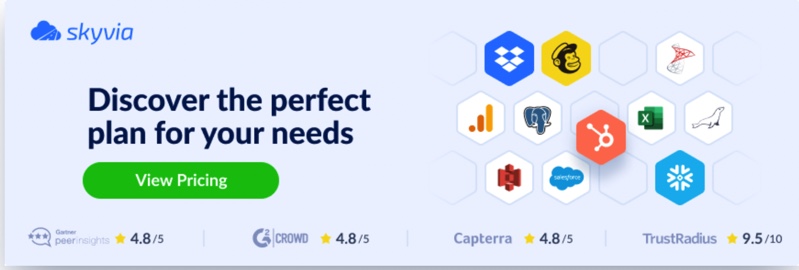What is Point-to-Point Integration?
Point-to-point (P2P) integration is a straightforward way to connect different systems and applications to exchange data and work together.If you’ve ever wondered how various software applications can talk to each other, this is one of the concepts making it happen. In this method, each application is directly linked to the others it needs to communicate with. That ensures that data is transferred quickly and accurately between systems, reducing potential errors.
Such an approach eliminates data silos and allows businesses to work faster and more efficiently.
Let’s consider how P2P works, its pros and cons, and business scenarios when this method might be the right choice for organizations compared to Hub-and-Spoke Integration, Enterprise Service Bus (ESB), and Integration Platform as a Service (iPaaS).
Table of Contents
Pros of Point-to-Point Integration
Cons of Point-to-Point Integration
Use Cases for Point-to-Point Integration
Best Practices for Implementing Point-to-Point Integration
Skyvia for Point-to-Point Integration
How It Works
Point-to-point integration uses a few approaches to connect the applications directly: custom coding, APIs, and a mix of both. Custom code offers high customization but needs appropriate technical expertise. APIs ensure standardized interactions, and combining both allows for complex workflows and powerful integrations.
The table below shows each method’s usage specifics.
| Method | Usage | Example Scenario |
|---|---|---|
| Custom Code | Directly write scripts or programs to connect applications. | A developer writes a custom script to extract data from an e-commerce platform and load it into an inventory management system, handling specific data transformations |
| APIs | Use application-specific APIs to exchange data between systems. | A CRM system uses the API of an email marketing tool to automatically add new contacts to a mailing list whenever a new lead is created. |
| Mix of Custom Code & APIs | Combine custom code with API calls to create flexible and powerful integrations. | A business combines custom code to extract and transform sales data from a CRM, and then uses APIs to load the data into both an accounting system and a data warehouse for reporting. |
Pros of Point-to-Point Integration
Simplicity
Point-to-point integration is straightforward to understand. It involves directly connecting two applications without complex middleware or integration platforms. This simplicity makes it accessible for small businesses and projects with limited technical resources.
Performance Efficiency
Point-to-point integration often results in faster data transfer and lower latency. This efficiency is critical for applications that require real-time data processing and quick response times.
Cost-Effectiveness
Setting up direct connections between a few applications is typically less expensive than implementing a full-scale integration platform. There are fewer components to purchase, configure, and maintain. Point-to-point integration is a budget-friendly option for businesses that need basic integrations without a hefty investment.
Minimal Initial Setup
Starting point-to-point integration requires establishing a direct link between the applications and configuring the data exchange. That allows businesses to integrate applications rapidly, speeding up deployment and time-to-value.
Flexibility in Customization
With custom code and APIs, companies can tailor the integration to meet specific business requirements and handle unique data formats or workflows. This flexibility ensures the integration works exactly as needed, accommodating any special cases or business rules.
Cons of Point-to-Point Integration
Scalability Issues
As the number of integrated applications grows, the direct connections increase exponentially. This makes it difficult to scale, as each new application requires multiple new connections, leading to a complex web of integrations. So, managing and maintaining these connections becomes increasingly challenging and resource-intensive.
Maintenance Challenges
Each direct connection in a point-to-point integration setup needs to be monitored, updated and maintained individually. Maintenance can become a significant burden as the number of connections grows, requiring more time and effort from the IT team.
Lack of Centralized Control
Point-to-point integration lacks a central hub or platform to manage and monitor all integrations, making it hard to get a complete view of the company’s integration landscape. Troubleshooting issues and ensuring data integrity across all systems becomes more difficult.
Security Concerns
Each direct connection must be individually secured and managed, increasing the potential for security gaps. It means a greater risk of data breaches and compliance issues if any connection is compromised.
Limited Reusability
Integrations created with custom code and APIs are often tailored to specific applications and use cases. These custom integrations are not easily reusable for other projects or applications. Developing new integrations for each particular need takes additional time and effort.
Use Cases for Point-to-Point Integration
Whether you’re a small business looking for cost-effective integration, a company needing to bridge modern apps with legacy systems, or working in a specific industry like healthcare, retail, or finance, point-to-point can do some magic, but let’s see how.
Cost-Effective Integration
Imagine you’re running a small business with a few key applications: an invoicing system, a CRM, and an email marketing tool. Point-to-point integration is perfect here. It allows setting up direct connections between the invoicing system and CRM to automatically update customer records when invoices are paid. Then, links the CRM to the email marketing tool to keep mailing lists updated. With custom code and APIs, this setup is easy, cost-effective, and up and running in no time.
Legacy Systems
A company relies on a trusty old ERP system that’s been around for years. Now, they’re adopting a new cloud-based CRM and need these systems to talk to each other. With point-to-point integration, they can directly connect ERP and CRM using custom code and APIs. This way, sales data from the CRM is automatically updated in the ERP, and inventory levels from the ERP are reflected in the CRM.
Specific Industry Examples
In a busy hospital, the patient management system keeps track of patient visits, treatments, and discharge information. The billing system, on the other hand, handles all the financial aspects. Point-to-point integration makes it possible to set up a direct connection between these two systems. A custom script ensures that every treatment recorded in the patient management system automatically updates the billing system.
In a retail store, sales happen fast, and workers need the inventory system to keep up. Point-to-point integration establishes a direct link between POS and inventory management systems. Every sale made at the POS updates inventory in real-time. This integration ensures the client never runs out of stock and always has accurate inventory levels, which helps with reordering and inventory planning.
Comparing Point-to-Point with Other Integration Methods
Choosing the proper integration method depends on the company’s specific needs, the scale of its integration projects, and budget. Let’s compare them to see how to select the one you need, according to the appropriate aspects.
| Aspect | Point-to-Point Integration | Hub-and-Spoke Integration | Enterprise Service Bus (ESB) | Integration Platform as a Service I(PaaS) |
|---|---|---|---|---|
| Architecture | Direct connections between applications. | Centralized hub that connects all applications (spokes). | Centralized bus that facilitates communication between applications. | Cloud-based platform for integrating multiple applications and services. |
| Simplicity | Simple to set up for a few applications. | Moderates complexity due to centralized hub. | High complexity with extensive configuration and management. | User-friendly with minimal setup; cloud-based simplicity. |
Scalability | Limited scalability; complexity grows exponentially with more applications. | More scalable than point-to-point, but can become a bottleneck at the hub. | Highly scalable, designed for large-scale integrations. | Highly scalable, designed for large-scale integrations. |
| Maintenance | High maintenance; each connection needs individual updates and management. | Centralized maintenance, but can become complex as the hub grows. | Centralized maintenance with potentially complex management. | Low maintenance; managed by the iPaaS provider. |
| Flexibility | High flexibility with custom code and APIs for specific use cases. | Moderates flexibility; customization is possible but demands more structure. | High flexibility with extensive configuration options. | High flexibility with pre-built connectors and customization options. |
Cost | Cost-effective for small projects. | Moderates cost. A centralized hub can be expensive to maintain. | High cost due to complexity and infrastructure requirements. | Cost-effective with subscription-based pricing models. |
| Performance | High performance for simple, direct connections. | Moderates performance; can be impacted by hub efficiency. | High performance, designed for handling large data volumes and complex workflows. | High performance with cloud scalability and optimization. |
Centralized Control | Lacks centralized control; no single view of integrations. | Centralized control through the hub. | Centralized control with detailed monitoring. | Centralized control with a single dashboard for managing integrations. |
Security | Each connection must be individually secured; higher risk of security gaps. | Centralized security at the hub; easier to manage but can be a single point of failure. | Centralized security with robust, enterprise-grade features. | High security, managed by the iPaaS provider, with end-to-end encryption. |
Best Practices for Implementing Point-to-Point Integration
A good plan is the foundation of a successful integration. It helps understand what businesses are connecting, why, and how. Start by identifying which systems need to be integrated and what data needs to flow between them. Make a clear map of the data flow and definite integration goals.
Planning and Design
As a business grows, its integration needs might change. Planning for scalability from the start can save a lot of headaches later.
Use modular design principles. This means building integration to make it easy to add new connections or modify existing ones without starting from scratch.
Testing and Validation
Testing helps catch errors and issues before they go live. It ensures integration works as expected and data flows correctly between systems. Set up a testing environment that mirrors the production setup as closely as possible. Run extensive tests, including edge cases, to ensure everything works correctly.
The validation ensures that the data being transferred is accurate and complete to maintain its integrity across systems.
Monitoring and Maintenance
Monitoring helps identify issues early before they impact the company’s operations. Regular maintenance keeps the integrations running smoothly.
Set up monitoring tools to track the integrations’ performance. Use dashboards to get a quick overview and set up alerts for potential issues.
Skyvia for Point-to-Point Integration

Skyvia is a cloud-based universal data integration tool created for businesses of all sizes that can manage, integrate, and automate their data flows. With its user-friendly interface and robust features, Skyvia makes complex integrations straightforward and accessible. Skyvia incorporates automation to streamline data integration processes, save time, and reduce manual interventions. It also offers attractive pay-as-you-go pricing models, including the free plan.
Go here to see the successful data integration story with Skyvia.

Conclusion
Point-to-point integration provides the simplicity, efficiency, and customization businesses need to create robust and reliable integrations. By embracing these abilities and following best practices, companies can ensure that systems remain connected and data flows seamlessly. Regardless of company size, point-to-point integration can help streamline operations, enhance data accuracy, and ultimately drive business success.
